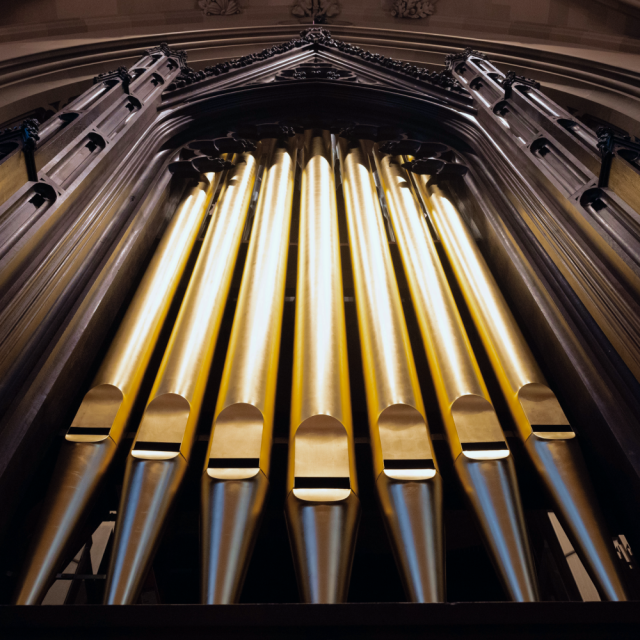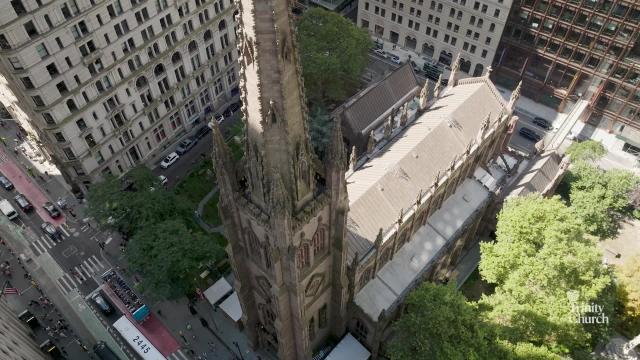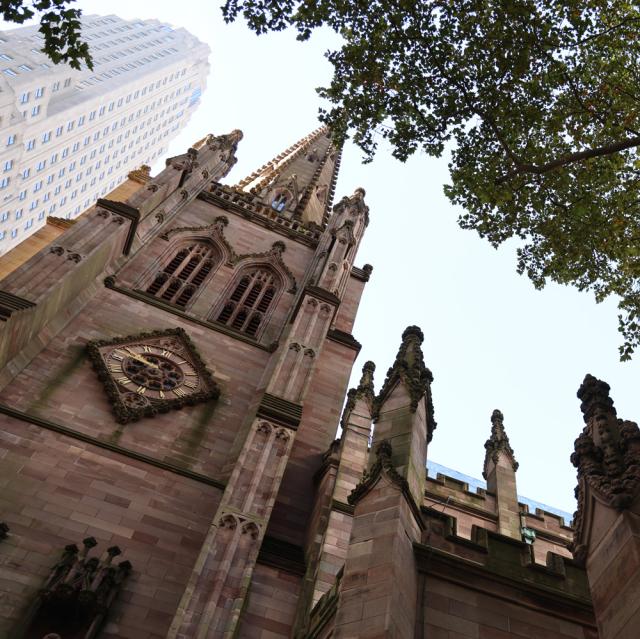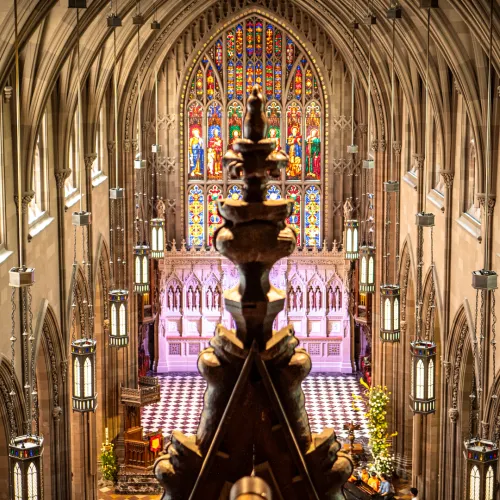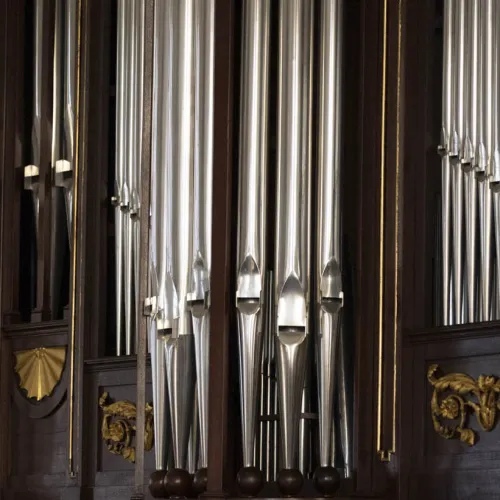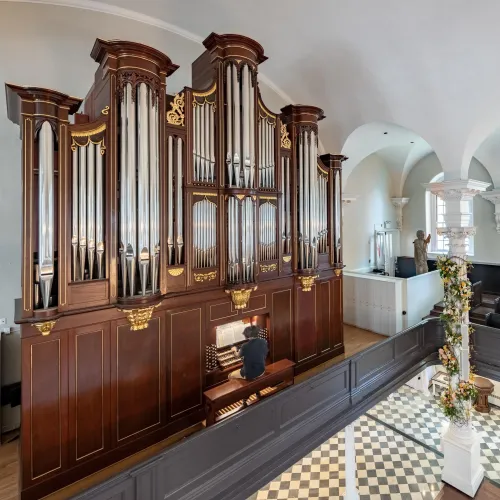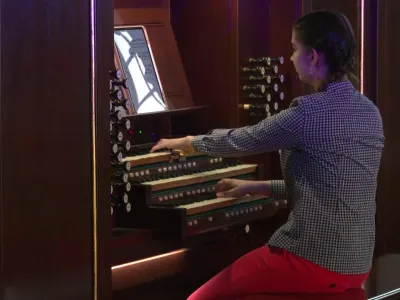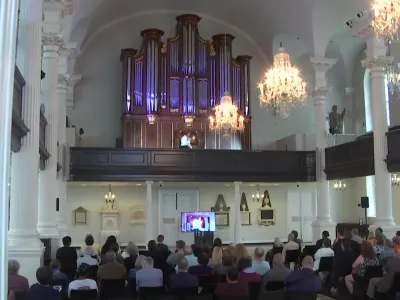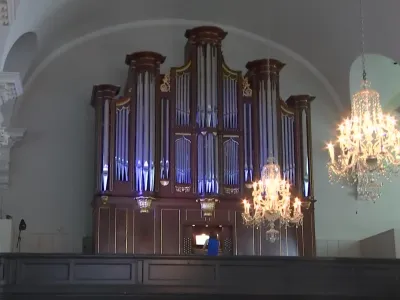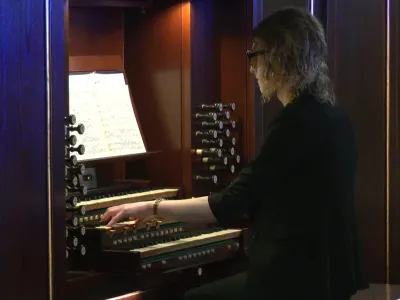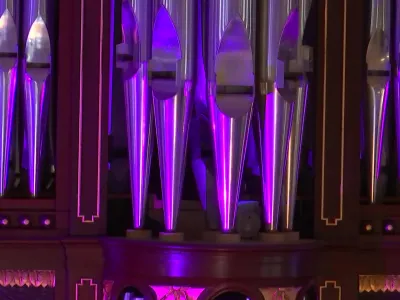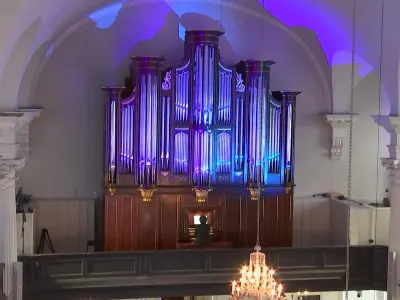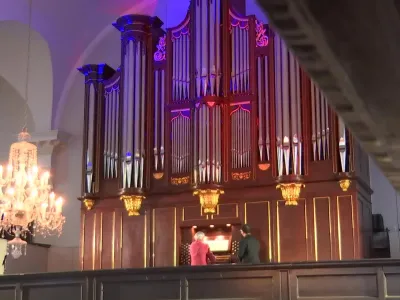Pipe Organs

Trinity Church is nearing the conclusion of an extensive multi-year project bringing three new pipe organs to our community.
Since the arrival of Trinity’s first organ in 1741, many instruments have helped lead our congregation’s worship services. Trinity’s current church building, designed by the architect Richard Upjohn in 1846, was originally furnished with an instrument from the master organ builder Henry Erben. The installation of an Opus 408 organ in 1923 marked the first time all organ forces were controlled by electric action from a single chancel console. It was eventually replaced by an organ from the Aeolian-Skinner company in 1970. From 2003 until 2017, Trinity used an experimental digital instrument, the Opus 1 from Marshall & Ogletree of Needham, Massachusetts.
Beginning in 2015, serious planning began to bring three new pipe organs to our community—one in St. Paul’s Chapel, the second in the intimate Chapel of All Saints , and the last in Trinity Church itself.
Trinity Church
In 2015, Glatter-Götz Orgelbau of Pfullendorf, Germany, with Manuel Rosales as tonal designer, were engaged to envision a new instrument for the nave of Trinity Church.
The new organ is conceived along the lines of its predecessors, a united instrument of 113 independent stops between chancel and gallery sections. The chancel has 29 stops across Great, Swell, Positiv, Solo, and Pedal. The gallery’s 84 stops are apportioned among Great, Swell, Choir, Chaire,Solo, and Pedal.
The organ’s appearance has undergone subtle changes. In the chancel, the side portions of both cases have been rearranged to house pipes in traditional practice. On the south (left) side, a new four-stop Positiv contains an eight-foot Principal in façade, with a flute chorus within. Opposite, the Great’s Diapason and Octave reside in the case, with the remainder of this department enclosed in the Swell. The doubly enclosed Solo contains a chorus of powerful trumpets alongside ethereal voices.
In the nave, Upjohn’s majestic 1846 case survives as the church’s oldest continuous piece of furniture. Minor alterations to the upper pipe flats have diversified the visual rhythms; the new tin façade pipes have been gilded in 23.5 karat gold leaf. The gallery railing, which once housed the Erben organ’s Choir section, now has a 10-stop Chaire division in a new case, with an intimate character on light wind pressure. Modifications to the gallery railing from 1970 have been reversed, and the new case sensitively integrated.” Modifications to the gallery railing from 1970 will be reversed, and the new case has been sensitively integrated. The interior departments are arranged in a traditional manner, with the Swell placed prominently, high up behind the crest point.
Notable features include two duophonic 32-foot stops, a quartet of tubas of differing characters on varying wind pressures, upper partial mutation stops at the intervals of the seventh and the ninth, and a double swell-box enclosing a brilliant reed battery and ethereal color stops. The mobile console, with its intricate decorative woodwork, allows leadership from the front section of the nave. Both consoles will control the entire instrument.
Learn more about the Opus 40 specifications.
St. Paul’s Chapel Organ
Noack Organ Company’s Opus 161, installed in St. Paul’s Chapel in 2017, is a reconstruction of an earlier Noack organ, Opus 111, installed at Church of the Redeemer in Chestnut Hill, Massachusetts in 1989. As Redeemer prepared to sell the Noack in 2015, Trinity set in motion the process of bringing this instrument to New York, being convinced of the Noack’s suitability for St. Paul’s Chapel.
In September 2015, Trinity Church commissioned Noack to study how Opus 111 could be re-engineered into the historic, although altered, organ case at St. Paul’s, originally furnished by English organ builder George Pike England in 1802. This case had been altered three times previously: in 1870, side wings and a crowning swell box were added; in 1928, a different swell box was installed 1928; and in 1964, the swell box was removed and new façade pipes installed. Noack’s president, Didier Grassin, deftly showed how subtle alterations could restore good proportions, while permitting all of Opus 111’s 29 stops to be fitted comfortably inside.
The revitalized organ arrived in September 2017 and was ready for use that November. Its formal debut in February 2018 included a full week of recitals, choral offerings, and concerts with NOVUS NY, Trinity Baroque Orchestra, The Choir of Trinity Church, and guest organists and soloists.
Today, the instrument leads worship at St. Paul’s Chapel and is featured in weekly Pipes at One recitals, welcoming guest organists from around the world.
Learn more about the Opus 161 specifications.
The Chapel of All Saints Organ
In August 2016, Trinity selected Richards, Fowkes & Co. of Ooltewah, Tennessee, to design a new organ, their Opus 26, for the Chapel of All Saints. Following a three-year design period, Trinity commissioned a 19-stop, two manual and pedal organ with an unusual design.
The new instrument was installed in 2023, with two keyboards and 27 foot pedals playing 1,148 pipes. Like most organs, the pipes are formed of numerous shapes and sizes: metal pipes both cylindrical and tapered, wood pipes (some pyramidal in form), and still others with beating brass tongues in tones imitative of baroque trumpets and oboes. But unlike most organs, this instrument’s tuning system is intentionally ancient, with unequal intervals between each key. The instrument has 15 pipes per octave, with separate pipes for D#/Eb, G#/Ab, and A#/Bb.
Most organs using this tuning system employ double-sharp keys, one piggybacking on the other, to permit access to each sub-semitone. In Opus 26, these pipes are selected by three mechanical levers, one for each pair of accidentals. As a result, some key signatures sound uncommonly pure, and others richly dissonant, following tuning systems used before the 19th century and particularly suited to Renaissance and early Baroque music.
The new organ is housed in the same alcove as its 1912 Hook-Hastings and 1984 Bozeman predecessors. The case, designed by the chapel’s architect Thomas Nash, has been renewed, extended, and fitted with new pipes gilded in 23.5-carat gold leaf. To each side, new screens of wood and wrought iron conceal the larger pipes at the organ’s left side. The key desk is directly below the organ behind the parclose screen, where every connection from key, pedal, and knob to mechanism and pipe, is entirely mechanical, giving the most direct connection between the fingers and the sound.
Learn More About Pipe Organs at Trinity
A Symphony of Sound
Genre-defying soloists. Visionary composers. A 10-year project to bring three new pipe organs to Trinity reaches its triumphant conclusion.
Behind the Scenes: Building Trinity’s Largest Organ
In 2015, organ builder Glatter-Götz Orgelbau and tonal designer Manuel Rosales came together to envision a new instrument for the nave of Trinity Church.
How Pipe Organs Work: Inside the St. Paul’s Chapel Organ
They’re among the oldest instruments in the Western world. But how do pipe organs create that transporting sound?

